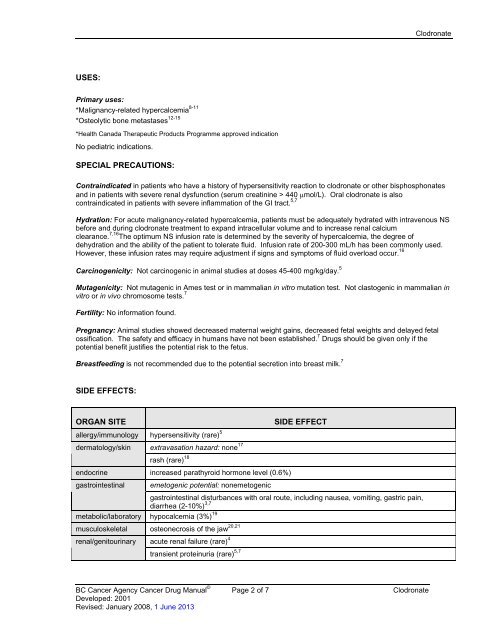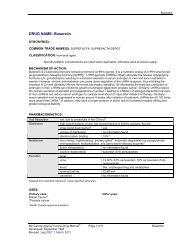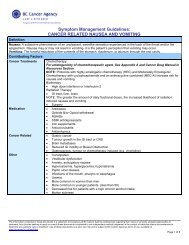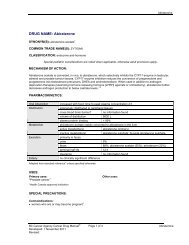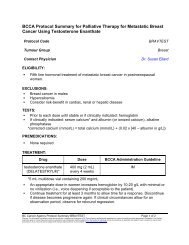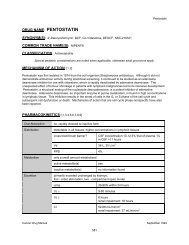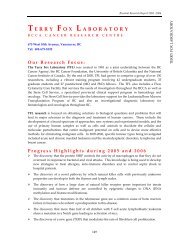Clodronate - BC Cancer Agency
Clodronate - BC Cancer Agency
Clodronate - BC Cancer Agency
You also want an ePaper? Increase the reach of your titles
YUMPU automatically turns print PDFs into web optimized ePapers that Google loves.
<strong>Clodronate</strong>USES:Primary uses:*Malignancy-related hypercalcemia 8-11*Osteolytic bone metastases 12-15*Health Canada Therapeutic Products Programme approved indicationNo pediatric indications.SPECIAL PRECAUTIONS:Contraindicated in patients who have a history of hypersensitivity reaction to clodronate or other bisphosphonatesand in patients with severe renal dysfunction (serum creatinine > 440 mol/L). Oral clodronate is alsocontraindicated in patients with severe inflammation of the GI tract. 5,7Hydration: For acute malignancy-related hypercalcemia, patients must be adequately hydrated with intravenous NSbefore and during clodronate treatment to expand intracellular volume and to increase renal calciumclearance. 7,16 The optimum NS infusion rate is determined by the severity of hypercalcemia, the degree ofdehydration and the ability of the patient to tolerate fluid. Infusion rate of 200-300 mL/h has been commonly used.However, these infusion rates may require adjustment if signs and symptoms of fluid overload occur. 16Carcinogenicity: Not carcinogenic in animal studies at doses 45-400 mg/kg/day. 5Mutagenicity: Not mutagenic in Ames test or in mammalian in vitro mutation test. Not clastogenic in mammalian invitro or in vivo chromosome tests. 7Fertility: No information found.Pregnancy: Animal studies showed decreased maternal weight gains, decreased fetal weights and delayed fetalossification. The safety and efficacy in humans have not been established. 7 Drugs should be given only if thepotential benefit justifies the potential risk to the fetus.Breastfeeding is not recommended due to the potential secretion into breast milk. 7SIDE EFFECTS:ORGAN SITESIDE EFFECTallergy/immunology hypersensitivity (rare) 5dermatology/skin extravasation hazard: none 17rash (rare) 18endocrine increased parathyroid hormone level (0.6%)gastrointestinal emetogenic potential: nonemetogenicgastrointestinal disturbances with oral route, including nausea, vomiting, gastric pain,diarrhea (2-10%) 3,7metabolic/laboratory hypocalcemia (3%) 19musculoskeletal osteonecrosis of the jaw 20,21renal/genitourinaryacute renal failure (rare) 4transient proteinuria (rare) 5,7<strong>BC</strong> <strong>Cancer</strong> <strong>Agency</strong> <strong>Cancer</strong> Drug Manual © Page 2 of 7 <strong>Clodronate</strong>Developed: 2001Revised: January 2008, 1 June 2013


